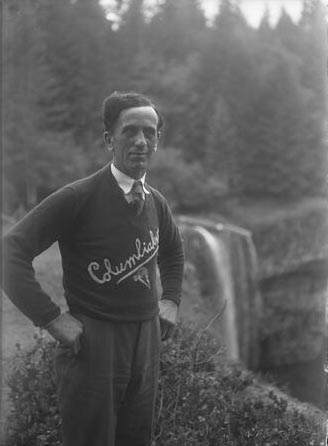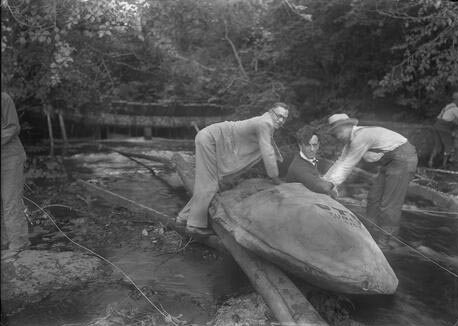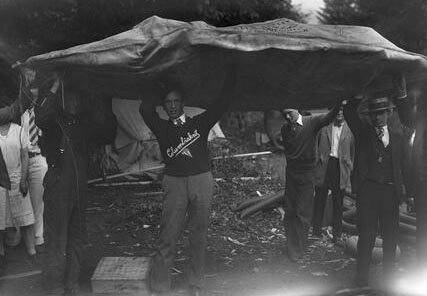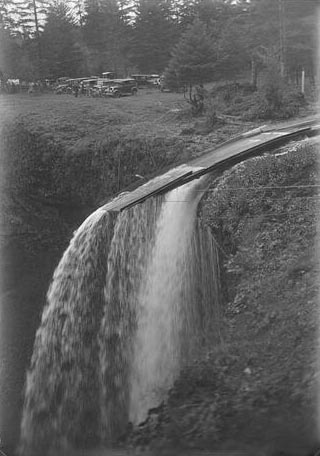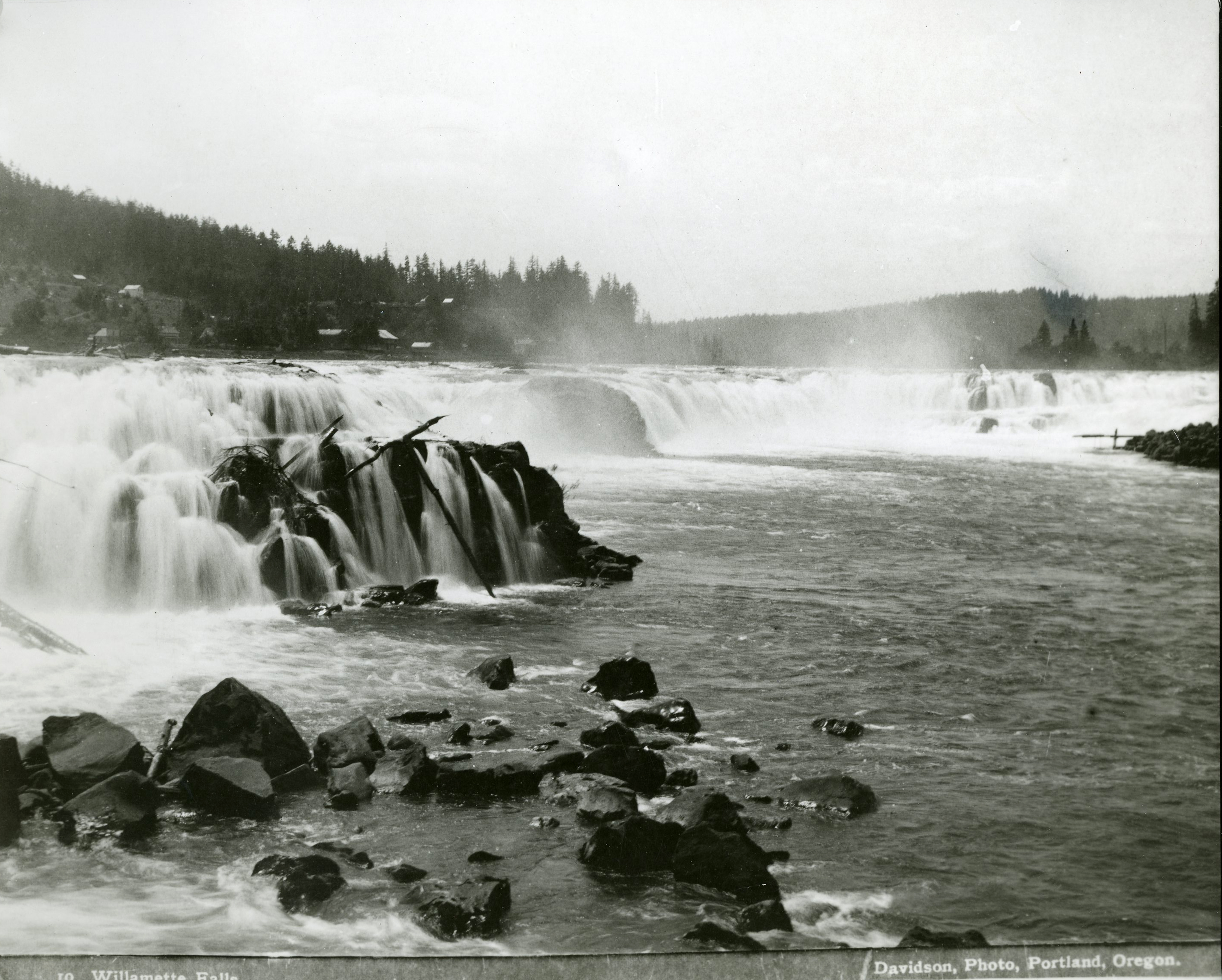Al Faussett was an accomplished daredevil in the Pacific Northwest who, from 1926 to 1929, traveled across Oregon, Washington, and Idaho to traverse seven waterfalls inside crafts he designed himself. His death-defying acts at Willamette Falls, Silver Creek Falls, and Celilo Falls in Oregon attracted thousands of spectators.
Alfred Isiah Faussett was born in 1879 to Irish immigrant farmers living near Princeton, Minnesota. In 1899, the family moved to Monroe, Washington, where Faussett found work as a logger. His first marriage ended in divorce in 1903, but he married a second time to Elvira “Vera” Schalkaw in 1908. Their first son died months after his birth, and they had a second son, Irvin, in 1910. Faussett was not content to be a logger and wanted the success that his father and older brothers were having in real estate and other ventures. According to his grandson, Guy Faussett, “[He] was always betting and wild and into something new … he always had some new scheme…because he was going to get rich somehow.” His erratic behavior led to his divorce in 1925.
In 1926, Faussett and a partner built a 32-foot dugout canoe from a single spruce log that they named the “Skykomish Queen.” His plan was to charge spectators $1 to witness him take the canoe over the 104-foot Sunset Falls on the Skykomish River, about sixty miles northeast of Seattle. Faussett accomplished the feat on May 30, 1926, without serious injury, but the ticket receipts were a disappointment as most spectators avoided the gate. He followed that up with a similar stunt at the nearby 28-foot Eagle Falls on September 6, 1926.
Ready for a new challenge, Faussett took a new barrel-shaped enclosure over the 186-foot Spokane Falls on June 1, 1927, with 10,000 spectators in attendance. The stunt did not go well. His craft made it over the lesser of two falls but sank to the bottom of the river and was caught in a whirlpool. Faussett had to be rescued from the craft, which was destroyed. He suffered a concussion, several broken ribs, and numerous contusions.
Undeterred, Faussett was ready to take his daredevil act to Oregon. On March 31, 1928, he took a new barrel-shaped craft over the 42-foot Willamette Falls. When he hit the pool at the bottom of the falls, the hatch blew open and the craft filled with water and disappeared under water for several minutes before reappearing downriver. Faussett had to be hospitalized for his injuries. As with his previous appearances, most spectators avoided paying the advertised fee.
In July, Faussett took his act to the 177-foot Silver Creek Falls (today’s South Falls) east of Salem with a new 12-foot canvas boat built for him by Hirsch-Weis, a Portland tent company. The boat had thirty-six inflated inner tubes inside and a guide ring attached to a cable to guide it to a smooth landing. Faussett also dammed the creek upstream to produce a strong release of water to boost him over the edge.
On July 1, 1928, more than 1,000 spectators assembled, some having paid the 50-cent admission fee, and Faussett wore a promotional sweater given to him by the Columbia Knit Company with their logo. None of his safety measures worked as planned. The water from the dam did not give him the boost he desired, and the boat had to be pushed over the edge of the falls. About halfway down, the guide ring hit a splice on the cable, ripping it off the boat, which then belly flopped about 60 feet into the pool beneath the falls, landing on its side. Spectator Albert Harris, age twelve, recalled the boat hitting the water: “Boy, it just went boom!”
Faussett was knocked out from the fall. He had sprained ankles, a fractured right hand, and serious internal injuries and was rushed to a hospital in Silverton. To make matters worse, his partner Keith McCullagh absconded with the admission proceeds and side bets—nearly $3,000 (about $57,000 in 2025 dollars)—and was later said to have left the country.
Faussett spent months recovering from his injuries, but in 1929 he was ready to go again, this time at 212-foot Shoshone Falls outside of Twin Falls, Idaho. On July 28, about 5,000 spectators watched him go over the falls in a new cigar-shaped craft with him inside encased in inner tubes described to be like the Michelin Man. Having suffered no injuries, he returned to Oregon in what would be his last stunt, at Celilo Falls on the Columbia River. Native fishermen warned Faussett that he would not survive the rocks at the base of the main falls, so Faussett chose to go over one of the lesser branches, which greatly disappointed the estimated 3,000 spectators, but he avoided injury.
In 1929, at age fifty, Faussett moved to Hollywood to attempt a new career as a stunt performer, but found no success. After living for a few years with relatives in Ukiah, California, Faussett moved to Portland in 1934, where he lived out his years doing odd jobs, including repairing cars and trucks in his backyard. He never gave up his dream of going over Niagara Falls and was building a boat for that purpose when he died at age sixty-eight in 1948. The Seattle Post Intelligencer noted his passing with a story headlined “Famed Stuntsman Dies in Bed.”
-
![]()
Al Faussett at South Falls at Silver Falls State Park, 1928. The falls and boat chute are visible behind him.
Oregon Historical Society Research Library, Digital Collection, June D. Drake photographs, 1863-2001, Org. Lot 678, Box 29, 235 -
![]()
Al Faussett sitting in his canvas and rubber boat, likely on the chute at the top of South Falls at Silver Falls State Park.
Oregon Historical Society Research Library, Digital Collections, June D. Drake photographs, 1863-2001, Org. Lot 678, Box 29, 232 -
![]()
Daredevil Alfred "Al" Faussett stands underneath his boat, presumably preparing to go over South Falls at Silver Falls State Park on July 1, 1928.
Oregon Historical Society Research Library, Digital Collections, June D. Drake photographs, 1863-2001, Org. Lot 678, Box 33, 622 -
![]()
A photograph of a boat chute installed at the top of South Falls at Silver Falls State Park for Al Faussett's waterfall run, 1928.
Oregon Historical Society Research Library, Digital Collections, June D. Drake photographs, 1863-2001, Org. Lot 678, Box 29, 228 -
![Faussett can be seen with his head protruding from a specially designed craft that he would ride over the falls. A group of surrounding men hand him inner tubes to provide buoyancy to the craft.]()
Al Faussett prepares to go over South Falls at Silver Falls State Park on July 1, 1928.
Faussett can be seen with his head protruding from a specially designed craft that he would ride over the falls. A group of surrounding men hand him inner tubes to provide buoyancy to the craft. Oregon Historical Society Research Library, Digital Collections, June D. Drake photographs, 1863-2001, Org. Lot 678, Box 26, 030 -
![]()
Al Faussett's canvas and rubber boat on the chute at South Falls at Silver Falls State Park.
Oregon Historical Society Research Library, Digital Collections, June D. Drake photographs, 1863-2001, Org. Lot 678, Box 29, 231
Related Entries
-
Celilo Falls
Celilo Falls (also known as Horseshoe Falls) was located on the mid-Col…
-
![Silver Falls State Park]()
Silver Falls State Park
Silver Falls State Park, located about twenty miles southeast of Salem,…
-
![Willamette Falls]()
Willamette Falls
The largest falls in Oregon and the sixth in the United States by volum…
Related Historical Records
Map This on the Oregon History WayFinder
The Oregon History Wayfinder is an interactive map that identifies significant places, people, and events in Oregon history.
Further Reading
Lindgren, Louse. "Faussett, Alfred Irvin (1879-1948)." HistoryLink.org, March 1, 2008.
"Daredevil logger injured trying to shoot over falls." Oregon Daily Journal, June 2, 1927.
Menez, G. "Remembering 'Daredevil Al' Faussett." Albany Democrat-Herald, June 15, 1995, p. 1.
"Logger succeeds in plunge over Shoshone Falls." The Daily Herald, July 30, 1929, p. 6.
"Faussett avoids big Celilo falls." The Capital Journal, September 23, 1929, p. 1.

